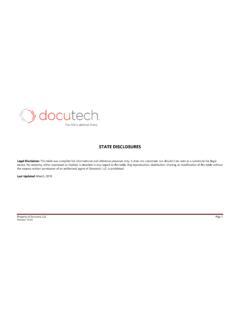Transcription of Strategies for optimizing your accounts receivable
1 Make your working capital work for youStrategies for optimizing your accounts receivablePart of the Deloitte working capital series2 The Deloitte working capital seriesStrategies for optimizing your accounts receivableStrategies for optimizing your accounts payableCash managementStrategies for optimizing your inventoryStrategies for optimizing your accounts receivable 1 Given the cost of new capital, no business can afford to let their existing capital go to waste. However, some businesses don t realize how much cash is trapped on their own balance sheets. Freeing up that cash by optimizing their working capital delivers more than improved operational efficiency. It also gives companies the added liquidity they need to fund growth, reduce debt levels, lower costs, maximize shareholder returns and even outperform their there are numerous ways to free up working capital, this series focuses on four core Strategies : accounts receivable , accounts payable, cash management and inventory.
2 This first installment looks at accounts It is better to receivethan to lendStrategies for optimizing your accounts receivable 3 Most businesses have formal accounts receivable policies that dictate when to bill, how much to bill and when to collect. Unfortunately, not all businesses enforce those policies effectively or even adopt the right processes at all. In many cases, it comes down to culture. Businesses that prioritize sales often fall into the trap of extending credit to customers, offering discounts or ignoring payment terms if it means winning new sales. However, if management does not have a focus on working capital, no one will. The upshot? You end up unintentionally providing customers with free financing. Some may argue this is no big deal, but the truth isn t so simple. If a company needs to borrow money to meet its obligations because customers are paying late, it could incur losses on the financing charges alone.
3 Even if that s not the case, carrying overdue accounts receivable still has a cost. It puts you on a cash flow tightrope. Rather than having free capital to invest in growth opportunities, increase shareholder payouts, buy new equipment or introduce new products, your money is tied up on your balance risksWhile no company intends to adopt weak accounts receivable policies, lack of planning, poor enforcement or a failure to focus on the function can result in unintended consequences. These often arise when companies: Fail to follow up with customers in a timely manner when payments are past due Allow sales reps to override credit limits and end up suffering losses from bad credit risks Neglect to provide staff with appropriate training on how to deal with late paying customers Don t pay sufficient attention to the accuracy of their bills, invoices or credit terms Allocate cash payments incorrectly, making it harder to figure out which payments are outstanding4 Adopting best practicesGaining access to this cash takes more than introducing new processes.
4 It also requires the finance and sales departments to work together to develop payment terms that make sense for both the business and its customers. While there are no hard-and-fast rules for achieving this end-state, certain best practices do exist. For example, businesses can realize cost efficiencies by centralizing accounts receivable processing, perhaps through a centre of excellence which develops and enforces common practices and standards. Similarly, by automating processes, you can eliminate manual data entry errors and reduce transaction key performance indicators (KPI) and defined metrics is also important. For instance, by adding working capital metrics to your standard revenue and profit tracking reports, you ll get a clear picture on items like days sales outstanding (DSO), the percentage of customers who pay late, the number of invoices or customers passed through your system, unreconciled items or accounts , the monthly percentage of write-offs, collection rates on bad receivables and even collection efforts made.
5 This will position you to track performance on an ongoing note on choosing KPIsRather than relying simply on a high-level metric like DSO, try to identify the metrics that impact DSO. After all, even if you know daily sales are 45 days outstanding, do you know if that s appropriate for your industry? To delve deeper, consider some more granular metrics, such as: How many invoices are past due? How many have unapproved discounts? How often does the sales team override standard terms? If overrides are frequent, should you change your terms? Strategies for optimizing your accounts receivable 5 There are five activities within the accounts receivable function that, if optimized, can help you free up cash and strengthen your working capital:1. Customer credit approvalFirst off, you need a process clear and concise policies for issuing credit and recovering debt in a timely fashion.
6 To do this, you need to: Set responsibilities. Solicit input from the sales team when setting policies to ensure market realities are reflected. For instance, you need to understand when to grant credit, circumstances that may merit overriding credit limits and situations that would justify placing accounts on hold. Once those policies are established, however, the finance team must enforce them and sales should not be authorized to issue credit or change terms without pre-approval. The aim is not to have finance interrupt the sales process, but to acknowledge as an organization that not all customers are good customers. Determine when to assess credit limits. If a new customer is buying low volume items on short terms, a simple internal scorecard may be sufficient to assess their creditworthiness. Conversely, if a new customer is interested in purchasing large volumes on a regular basis, you may need a more stringent process, such as full background and credit history checks.
7 Commit to approving or rejecting credit applications within a certain time period. Often, companies lack policies around how long it should take to turn around credit applications. If the time frame lags, it could result in lost sales and put a strain on the relationship between sales and finance a relationship that demands cooperation if companies hope to realize long-term success. Regularly review the credit approval process. As customers and industries change, risk profiles change as well. If customers are in a high-growth industry, or one struggling against economic conditions, you may want to alter their credit terms. That means you ll need to review your credit approval process on a regular basis, and set policies around this too. For instance, will you ask for financial statements from customers? Will you grant terms for only limited time periods?
8 2. Customer master dataOnce you assign credit limits, payment terms, discounts, tax rates and return policies, and any other relevant terms ( delivery address,e-mail address etc.) to specific customers, those terms must be accurately reflected in your billing and collection systems. Customer master data should indicate what the customer is allowed to purchase, any dollar limits that apply, payment terms, whether they get volume discounts or advertising credits, and any other relevant this wrong is more than a data entry glitch. For instance, if you enter an incorrect address, invoices go to the wrong place and receivables slow down. Likewise, if your master data indicates payment terms of 60 days when it should be 30, you won t be paid on time. Recognize, too, that the master data must be updated if a customer s credit profile changes. For instance, if you grant additional credit to a customer, this should be reflected in the system.
9 Companies have a habit of assuming the master system trumps all, but that s only true if data accuracy is being To get the most out of your data, you need to: Centralize the master data process and identify who should ultimately manage customer data* Conduct regular audits of master data to identify customers with abnormal credit limits, payment terms, and/or discount rates Document and communicate all changes to customer data. Changes should be approved by Finance and operations as they can have a significant impact on cash-flow forecasting Implement controls to ensure data accuracy and permit read-only access to staff to ensure they can t override customer data without proper sign-off3. Invoicing/billingYou d imagine that billing is fairly straightforward, but companies often struggle in this area. Some make consistent invoice errors regarding units of measure, price, customer accounts or other inaccurately reflected master data.
10 Some fail to generate invoices in a timely fashion or at all. Sometimes, team members make an end-run and bill outside the system. In other cases, companies bounce back and forth between mailed and electronic invoices, resulting in confusion. The key here is to establish a billing process that ensures accurate invoices are sent on a timely basis. To do this, organizations should consider the following Strategies : Automation: can reduce time and human error Timely/effective invoice generation and reporting: can ensure billing is completed in a timely basis and reports are relevant to the end-user Electronic billing systems: EDI/electronic invoices can reduce delivery time and allow customers to download their invoices directly into their own accounting system Exception reports: can help to flag account anomalies ( exceeding credit limits, discount rates above company policy, etc.)














